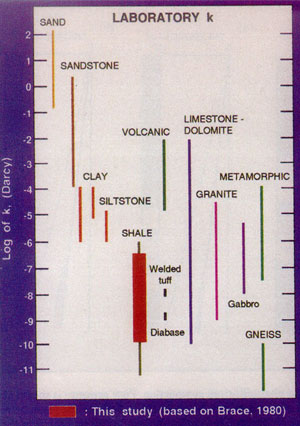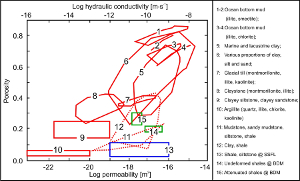| |||||||
|
|
|||||||
|
|
|||||||
| Porosity and Permeability of Shale and Smeared Shale | |||||||
|
The permeability of shale is among the lowest for various rock types (Figure 1). It has been reported (Best and Katsube, 1995) that tight shales from a depth of 2 to 6 km have permeabilities of 0.1 to 300 nanodarcies. They are 6 to 12 orders of magnitude lower than those for sandstone.
However, what are identified as shales may show wide properties. Figure 2 shows a wide variation in conductivity of shales from various environments (Nuezil, 1994). Smeared shales (Numbers 13, 14, and 15) are even tighter in the direction perpendicular to the direction of shearing because of realignment of platy minerals and development of planar fabric. When shale is entrained into fault zones and hence attenuated and smeared, the fault-normal permeability may be significantly reduced with respect to the permeability of undeformed shale. The Shale Gouge Ration (SGR, Yielding, 1997) has been used empirically to estimate the sealing or no-sealing of a fault with shale smear. A fault with shale smear is considered sealing when the vertical component of the fault slip exceeds the thickness of the shale layer, until when the shale gouge ratio dropped below a threshold between 25% and 15%. Physically-based evaluation of shale smear potential can be made by identifying major fault segments on the seismic profile and mapping smeared shale on a juxtaposition diagram (Koledoye, 2003). | |||||||
| Reference: |
|||||||
| Best, M.E., Katsube, T.J., 1995 Koledoye, B., Aydin, A., May, E., 2003 Yielding, G., Freeman, B., Needham, T., 1997 |
|||||||
|
Readme | About Us | Acknowledgement | How to Cite | Terms of Use | Ⓒ Rock Fracture Knowledgebase |
|||||||

